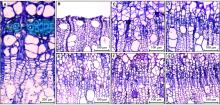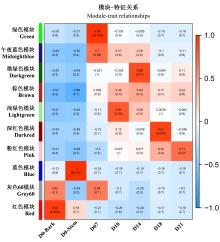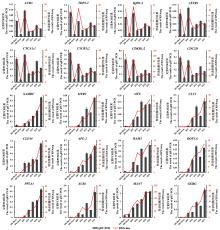

Scientia Silvae Sinicae ›› 2021, Vol. 57 ›› Issue (9): 52-65.doi: 10.11707/j.1001-7488.20210906
Previous Articles Next Articles
Fang Tang1,2,Shutang Zhao1,2,Lijuan Wang1,2,Xueqin Song1,2,Mengzhu Lu1,2,3,*
Received:2021-02-03
Online:2021-09-25
Published:2021-11-29
Contact:
Mengzhu Lu
CLC Number:
Fang Tang,Shutang Zhao,Lijuan Wang,Xueqin Song,Mengzhu Lu. Gene Expression of Secondary Vascular System Regeneration in Populus tomentosa[J]. Scientia Silvae Sinicae, 2021, 57(9): 52-65.
Table 1
The sequence of primers for real-time quantitative PCR"
| 基因名称 Gene name | 正向引物序列 Forward primer sequence(5′—3′) | 反向引物序列 Reverse primer sequence(5′—3′) |
| AUR3 | TCAGTCACCCTAACATTCTCCGTCT | AGATAACCGCACTTTCTAAGCTCT |
| TOP2-2 | AGTAACATGCACCTCTTTGATTCAGC | CCTTGTCTCGTAGTATTCAAGCCGTA |
| IQD1-2 | CCACCCAAGTCCTGTGTAGATGCAA | AGGTCTCGCTGAAATTCTAGTGGT |
| ATXR1 | AGCGCTCAAAGATTGTGATCAAGCA | GCAATCCAAGGCCATTGAGTACCTG |
| CYCA1;1 | AGGTGGAAGAGTTTTGCTACATTACCG | GCAGCACGAACAAATCGCCTCA |
| CYCB1;2 | ACACTATGTTTTCCTTGCTCGCTTC | ACTGTGTCATAATGCATCAAGCCCAA |
| CDKB1;2 | AATCCCTCTAAGCGCAACCAC | AGAATCGATGAATTTCTTGAGATCCG |
| CDC2D | AGGGATCTTAAGCCTCATAACCTGT | AAGGACTTCAGGAGCTCTATACCAC |
| SAMDC | CCGTTGAGCAAAGATCACACGTCT | ACATTTTAGTCATCTCAGCAGCCGAA |
| MYR2 | AATTCCTGGACTTACCTTGTACCAC | ATTTTGCTGCTCCCAATATTAGCTTG |
| OUT | TGCCAATCACTGTATACATGCGAGA | TGCCCATAACCGTGATACAGGACA |
| CLV1 | CTCTGTTATCTTCACCACGATTGCT | CCTGCATCTTGTAAGAACTTAGCGAGA |
| CLE44 | GCAGAACCACGACAAAATTACAAGC | AGTTTCTTGGATAAATCTATGGGACGAG |
| APL-2 | AAATTCAGACTTGGAAAGCAACCAC | CAGATGAAGATGCTGCACTTCGT |
| BAM3 | CGTCTCATGATAATGGCCTATCTGCT | AGGCTTCCATTTGGCATGTACTCGT |
| DOF3.6 | TGCACTTCCATCACAGGTTATTGGTC | TTAACCCAATGTTTCCCTCGCCGAA |
| PP2A1 | ACTGGTTCTCCCAAATGGATACAAGC | AACTGGCACTTCAATCCATTGCTCT |
| SUS6 | ATAGAAAATAAGGTCCTCCGCCAGT | AAATTCCCATCAGTGTAGTTTCCGAT |
| MAN7 | CAAGTGAAGAAAGCCAAGAATCGTT | GGTCCCTTTGATTATCATTCGACGTT |
| GEBG | TTATGTGCCAGCCACCAATATCGTC | TGATTCTATGGTCTAATGATGCACGAAC |
| PP2A-2 | ACAGTTCAACCACACTAATGGGCTC | TTTGGCGCACTGAACACTGTAACCAC |

Fig.1
Cross sections of a portion of trunks during secondary vascular system(SVS) regeneration in Populus tomentosa A: The phloem, cambium and most of the immature xylem could be seen in the peeled bark tissue; B: The surface of the girdled trunk remained a few layers of immature xylem and mature xylem from outside to inside; C-G: The regenerated tissue on the surface of the trunk on the day 7th, 10th, 14th, 18th and 21st after girdling."


Fig.3
Correlation between different modules and samples D0-Bark and D0-Stem represent the inner bark and trunk surface samples after girdling(Day 0), respectively, and D07, D10, D14, D18 and D21 represent the regeneration samples on the day 7th, 10th, 14th, 18th and 21st after girdling, respectively. The same below. The value in each square represents the correlation between each module and regeneration samples, and the value in brackets is the corresponding P-value."


Fig.11
Validation of HUB genes and key regulatory genes in Grey60 and Pink modules by qRT-PCR The column represents the results of qRT-PCR, with the coordinate axis on the left; the line represents the results of RNA sequencing, with the coordinate axis on the right; the abscissa is the samples during SVS regeneration."

| 丁健, 王飞, 金景姬, 等. 表观遗传之染色质重塑. 生物化学与生物物理进展, 2015, 42 (11): 994- 1002. | |
| Ding J , Wang F , Jin J J , et al. Epigenetic chromatin remodeling. Progress in Biochemistry and Biophysics, 2015, 42 (11): 994- 1002. | |
| 高秀华, 傅向东. 赤霉素信号转导及其调控植物生长发育的研究进展. 生物技术通报, 2018, 34 (7): 1- 13. | |
| Gao X H , Fu X D . Research progress for the gibberellin signaling and action on plant growth and development. Biotechnology Bulletin, 2018, 34 (7): 1- 13. | |
| 韩惠宾, 张国华, 王国栋. 细胞分裂素参与植物维管系统发育的信号转导研究进展. 植物生理学报, 2015, 51 (7): 996- 1002. | |
| Han H B , Zhang G H , Wang G D . Progress on cytokinin signaling in plant vascular development. Plant Physiology Journal, 2015, 51 (7): 996- 1002. | |
| 贺窑青, 郑彩霞. 植物细胞周期调控因子及其功能的研究进展. 植物生理学通讯, 2010, 46 (10): 973- 979. | |
| He Y Q , Zheng C X . Research progress on cell cycle regulators and their functions in plant. Plant Physiology Communications, 2010, 46 (10): 973- 979. | |
| 秦尚尧, 袁一旻, 胡昕, 等. 拓扑异构酶Ⅱ的结构、功能及作用机制研究进展. 生理学报, 2016, 68 (1): 98- 106. | |
| Qin S Y , Yuan Y M , Hu X , et al. Structural, mechanistic and functional insights into topoisomerase Ⅱ. Acta Physiologica Sinica, 2016, 68 (1): 98- 106. | |
| 王金利, 史胜青, 贾利强, 等. 植物泛素结合酶E2功能研究进展. 生物技术通报, 2010, (4): 7- 10. | |
| Wang J L , Shi S Q , Jia L Q , et al. Progress on functions of ubiquitin-conjugating enzyme(E2) in plants. Biotechnology Bulletin, 2010, (4): 7- 10. | |
|
张佳景, 丁淑丽, 邹宜静, 等. 植物腺苷甲硫氨酸脱羧酶研究进展. 中国细胞生物学学报, 2008, 30 (5): 622- 628.
doi: 10.3969/j.issn.1674-7666.2008.05.015 |
|
|
Zhang J J , Ding S L , Zou Y J , et al. Research advance on S-adenosylmethionine decarboxylase in plants. Chinese Journal of Cell Biology, 2008, 30 (5): 622- 628.
doi: 10.3969/j.issn.1674-7666.2008.05.015 |
|
| 郑洁, 王磊. 油菜素内酯在植物生长发育中的作用机制研究进展. 中国农业科技导报, 2014, 16 (1): 52- 58. | |
| Zheng J , Wang L . Advance in mechanism of brassinosteroids in plant development. Journal of Agricultural Science and Technology, 2014, 16 (1): 52- 58. | |
|
Birnbaum K D , Alvarado A S . Slicing across kingdoms: Regeneration in plants and animals. Cell, 2008, 132 (4): 697- 710.
doi: 10.1016/j.cell.2008.01.040 |
|
|
Chen C , Chen H , Zhang Y , et al. TBtools: An integrative toolkit developed for interactive analyses of big biological data. Molecular Plant, 2020, 13 (8): 1194- 1202.
doi: 10.1016/j.molp.2020.06.009 |
|
| Cui K M , Wu S Q , Wei L B , et al. Effect of exogenous IAA on the regeneration of vascular tissues and periderm in girdled Betula pubescens stems. Chinese Journal of Botany, 1995, 7 (1): 17- 23. | |
|
Demidov D , Lermontova I , Weiss O , et al. Altered expression of aurora kinases in Arabidopsis results in aneu- and polyploidization. The Plant Journal, 2014, 80 (3): 449- 461.
doi: 10.1111/tpj.12647 |
|
|
Depuydt S , Rodriguez-Villalon A , Santuari L , et al. Suppression of Arabidopsis protophloem differentiation and root meristem growth by CLE45 requires the receptor-like kinase BAM3. Proceedings of the National Academy of Sciences, 2013, 110 (17): 7074- 7079.
doi: 10.1073/pnas.1222314110 |
|
|
Dinant S , Clark A , Zhu Y , et al. Diversity of the superfamily of phloem lectins(phloem protein 2) in angiosperms. Plant Physiology, 2003, 131, 114- 128.
doi: 10.1104/pp.013086 |
|
|
Du J , Xie H L , Zhang D Q , et al. Regeneration of the secondary vascular system in poplar as a novel system to investigate gene expression by a proteomic approach. Proteomics, 2006, 6 (3): 881- 895.
doi: 10.1002/pmic.200401348 |
|
|
Feng S , Jacobsen S E . Epigenetic modifications in plants: an evolutionary perspective. Current Opinion in Plant Biology, 2011, 14 (2): 179- 186.
doi: 10.1016/j.pbi.2010.12.002 |
|
|
Fukuda H , Hirakawa Y , Sawa S . Peptide signaling in vascular development. Current Opinion in Plant Biology, 2007, 10 (5): 477- 482.
doi: 10.1016/j.pbi.2007.08.013 |
|
|
Guo Y F , Han L Q , Hymes M , et al. CLAVATA2 forms a distinct CLE-binding receptor complex regulating Arabidopsis stem cell specification. The Plant Journal, 2010, 63 (6): 889- 900.
doi: 10.1111/j.1365-313X.2010.04295.x |
|
|
Ikeuchi M , Favero D S , Sakamoto Y , et al. Molecular mechanisms of plant regeneration. Annual Review of Plant Biology, 2019, 70 (1): 377- 406.
doi: 10.1146/annurev-arplant-050718-100434 |
|
|
Lee J R , Boltz K A , Lee S Y . Molecular chaperone function of Arabidopsis thaliana phloem protein 2-A1, encodes a protein similar to phloem lectin. Biochemical and Biophysical Research Communications, 2014, 443 (1): 18- 21.
doi: 10.1016/j.bbrc.2013.11.034 |
|
| Li C L , Cui K M , Yu C S , et al. Anatomical studies of regeneration after ringing of Eucommia ulmoides. Journal of Integrative Plant Biology, 1981, 23 (1): 6- 11. | |
|
Pang Y , Zhang J , Cao J , et al. Phloem transdifferentiation from immature xylem cells during bark regeneration after girdling in Eucommia ulmoides Oliv. Journal of Experimental Botany, 2008, 59 (6): 1341- 1351.
doi: 10.1093/jxb/ern041 |
|
|
Rolland-Lagan A-G , Prusinkiewicz P . Reviewing models of auxin canalization in the context of leaf vein pattern formation in Arabidopsis. The Plant Journal, 2005, 44, 854- 865.
doi: 10.1111/j.1365-313X.2005.02581.x |
|
|
Stobbe H , Schmitt U , Eckstein D , et al. Developmental stages and fine structure of surface callus formed after debarking of living lime trees(Tilia sp.). Annals of Botany, 2002, 89 (6): 773- 782.
doi: 10.1093/aob/mcf137 |
|
| Tang F , Wei H R , Zhao S T , et al. Identification of microRNAs involved in regeneration of the secondary vascular system in Populus tomentosa Carr. Frontiers in Plant Science, 2016, 7, 724. | |
| Wang M J , Qi X L , Zhao S T , et al. Dynamic changes in transcripts during regeneration of the secondary vascular system in Populus tomentosa Carr. revealed by cDNA microarrays. BMC Genomics, 2009, 10 (1): 215. | |
|
Willmann M , Mehalick A , Packer R , et al. MicroRNAs regulate the timing of embryo maturation in Arabidopsis. Plant Physiology, 2011, 155, 1871- 1884.
doi: 10.1104/pp.110.171355 |
|
|
Zang J , Klemm S , Pain C , et al. A novel plant actin-microtubule bridging complex regulates cytoskeletal and ER structure at ER-PM contact sites. Current Biology, 2021, 31 (6): 1251- 1260.
doi: 10.1016/j.cub.2020.12.009 |
|
|
Zhang J , Gao G , Chen J J , et al. Molecular features of secondary vascular tissue regeneration after bark girdling in Populus. New Phytologist, 2011, 192 (4): 869- 884.
doi: 10.1111/j.1469-8137.2011.03855.x |
| [1] | Jinchi Wang,Qinglin Huang,Minghai Yan,Ruchu Huang,Qunrui Zheng. Characteristics of 13-Year-Old Cyclobalanopsis glauca Natural Forest Converted from Eucalyptus grandis Plantation [J]. Scientia Silvae Sinicae, 2021, 57(9): 13-20. |
| [2] | Zhen Li,Tingting Yuan,Chenglei Zhu,Kebin Yang,Xinzhang Song,Zhimin Gao. Molecular Characteristics and Patterns of Gene Expression of Ammonium Transporter in Moso Bamboo [J]. Scientia Silvae Sinicae, 2021, 57(7): 70-79. |
| [3] | Yuequ Chen,Qingzhen Liu,Limei Li,Yang Zhang,Jiao Han,Yong'an Zhang. Screening and Identification of Antagonistic Streptomyces for Biocontrol of Poplar Canker [J]. Scientia Silvae Sinicae, 2021, 57(7): 92-100. |
| [4] | Yang Qu,Qin Guo,Tian Li,Ziyun Zhao,Haitao Yue,Jie Yang,Qiang Wang. Preparation and Characterization of Hot-Pressed Peanut Meal Based Adhesive [J]. Scientia Silvae Sinicae, 2021, 57(6): 144-149. |
| [5] | Xiaotong Kang,Hui Chen. Cloning and Expression of alpha-pinene synthase and (-)-limonene synthase Genes in Pinus armandi [J]. Scientia Silvae Sinicae, 2021, 57(6): 180-188. |
| [6] | Yahui Miao,Dan Ju,Kehao Liang,Aibin Wang,Junling Liu,Lingyun Zhang. Cloning and Functional Analysis of Transcription Factor Gene PwNF-YB8 from Picea wilsonii [J]. Scientia Silvae Sinicae, 2021, 57(5): 77-92. |
| [7] | Yanli Gao,Zhijie Yang,Li Zhang,Decheng Xiong. Effects of Different Regenerated Models on Soil Nitrogen Mineralization in Subtropical Evergreen Broad-Leaved Forest [J]. Scientia Silvae Sinicae, 2021, 57(4): 24-31. |
| [8] | Ping She,Bing Cao,Yanhui Wang,Zhijia Yu,Zheng Wang,Jie Ma,Baoguang Jia. Effect of Forest Floor Treatments on Density of the First-Year Seedlings in Larix principis-rupprechtii Plantation [J]. Scientia Silvae Sinicae, 2021, 57(3): 18-28. |
| [9] | Hui Liu,Xiaoqin Wu,Jianren Ye,Dan Chen. Phosphate-Dissolving Mechanisms of Pseudomonas fluorescens and Its Colonizing Dynamics in the Mycorrhizosphere of Poplars [J]. Scientia Silvae Sinicae, 2021, 57(3): 90-97. |
| [10] | Xinyi Zhou,Liqiong Yan,Yuntong Lü,Lili Sun,Jingwen Zhu,Chuanwang Cao. Activities and Gene Expressions of Phenylpropane Metabolic Enzymes in Populus simonii×P. nigra by Herbivore Induction of Lymantria dispar (Lepidoptera: Lymantriidae) [J]. Scientia Silvae Sinicae, 2021, 57(3): 108-116. |
| [11] | Changming Ma,Hanhan Zhang,Yu Han,Qingxing Meng,Jinsong Zhang,Yujie Ma. Error and Correction Formula of Granier's Original Formula to Calculate the Stem Sap Flux Density of Clone 107 Poplar [J]. Scientia Silvae Sinicae, 2021, 57(3): 161-169. |
| [12] | Minhao Liu,Long Li,Jing Ye,Xuanyuan Zhou,Zhouqi Li,Ruishen Fan,Junlei Xu. Genome-Wide Identification and Expression Analysis of the ARF Gene Family in Eucommia ulmoides [J]. Scientia Silvae Sinicae, 2021, 57(3): 170-180. |
| [13] | Jinchi Wang,Qinglin Huang,Minghai Yan,Ruchu Huang,Qunrui Zheng. Characteristics of 7-Year-Old Castanopsis fargesii Natural Forest Converted from Eucalyptus dunnii Plantation [J]. Scientia Silvae Sinicae, 2021, 57(1): 12-19. |
| [14] | Limin Wang,Yahui Chen,Qingshan Yang,Ritao Qu,Jiang Jiang,Jinchi Zhang,Hongxia Zhang,Zhizhong Song. Cloning and Functional Analysis of Potassium Channel Gene PdbSKOR in Populus davidiana×P. bolleana [J]. Scientia Silvae Sinicae, 2021, 57(1): 53-63. |
| [15] | Chenglei Zhu,Kebin Yang,Xiurong Xu,Shuang Ma,Xiaopei Li,Zhimin Gao. Molecular Characteristics of NIP Genes in Phyllostachys edulis and Their Expression Patterns in Response to Stresses [J]. Scientia Silvae Sinicae, 2021, 57(1): 64-76. |
| Viewed | ||||||
|
Full text |
|
|||||
|
Abstract |
|
|||||